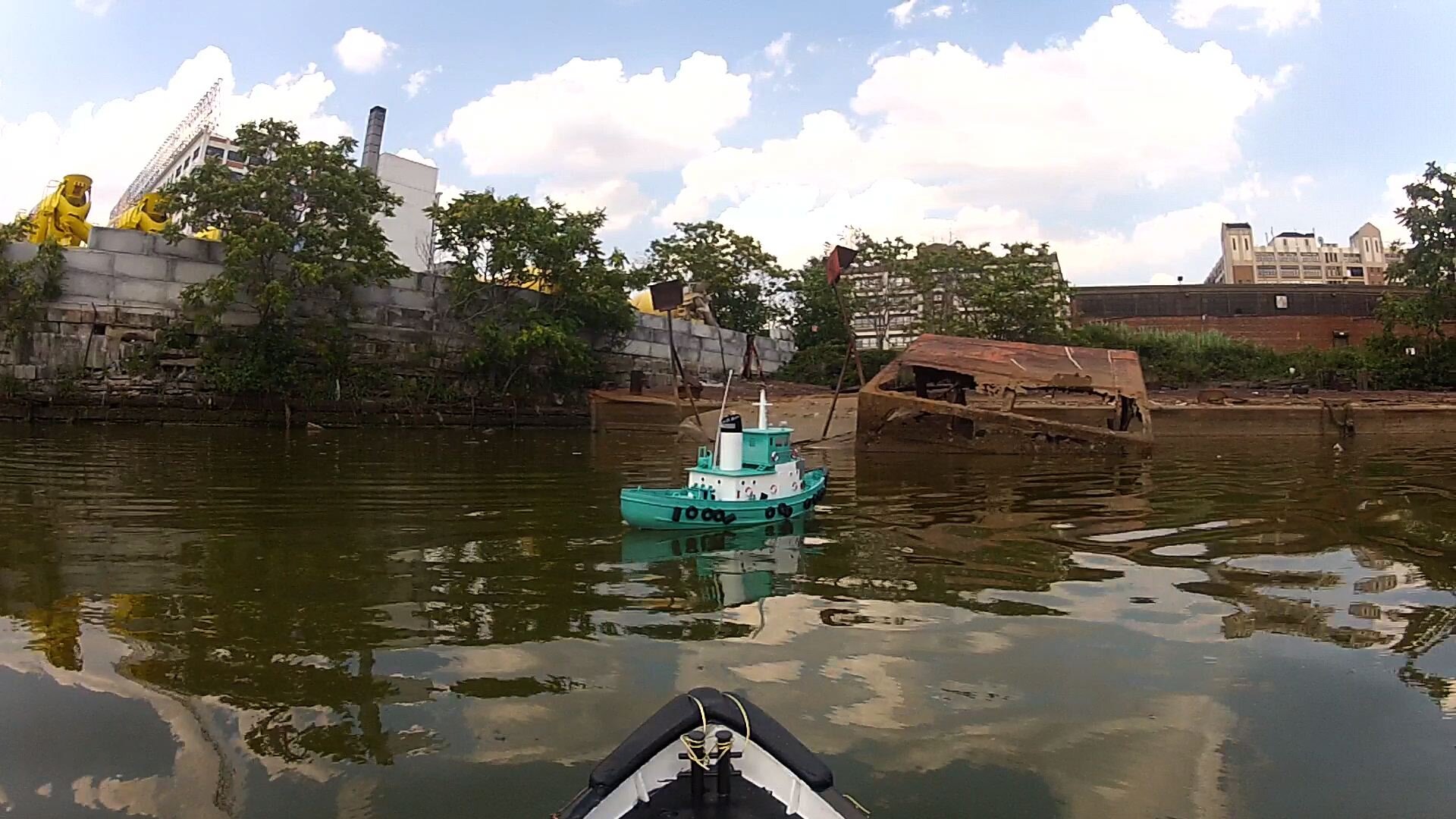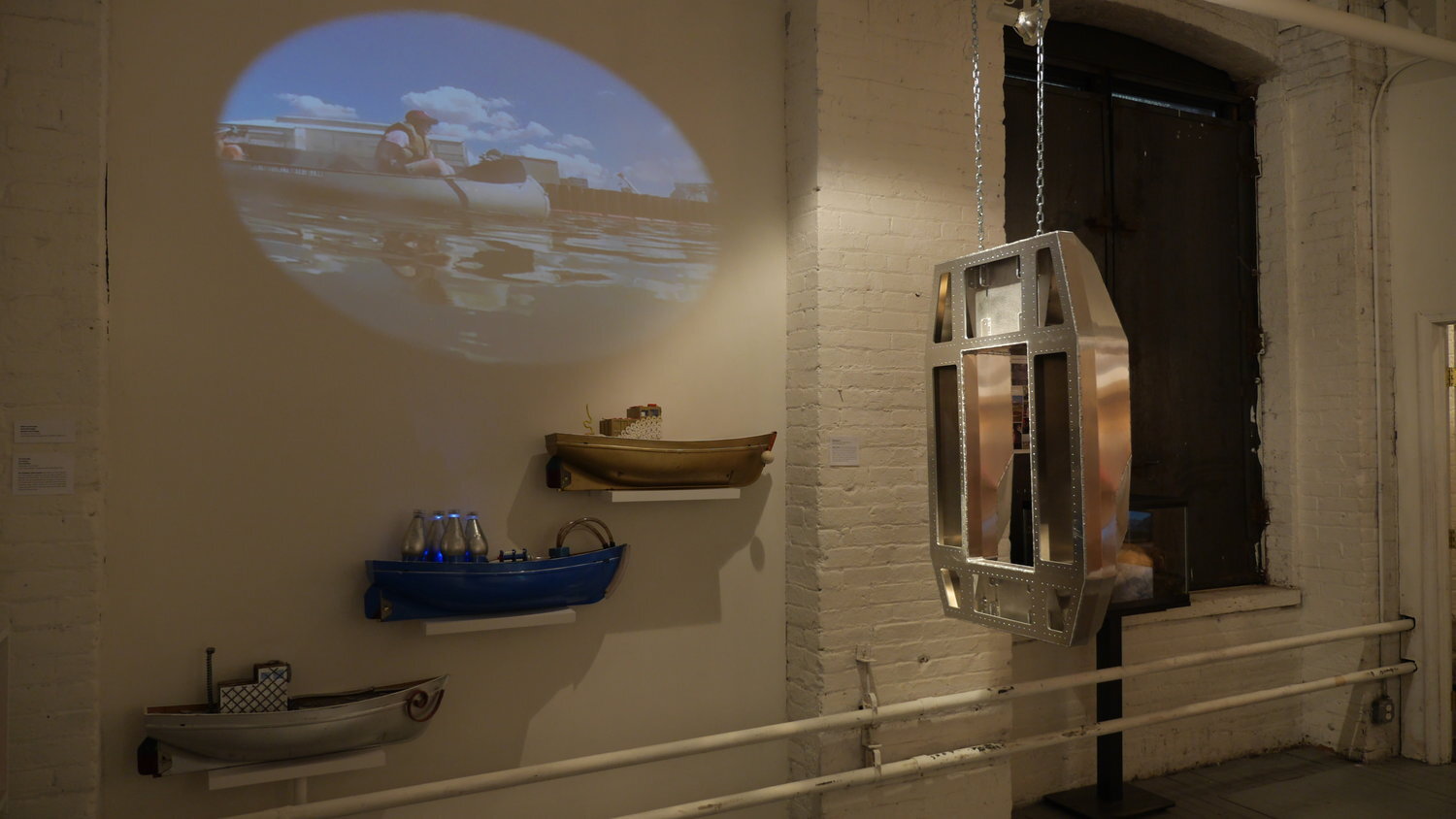The Newtown Creek Armada was a site-specific interactive art project that invited the public to explore the past, present and future of the Newtown Creek, one of the most polluted bodies of water in the United States. A tidal estuary bordering Brooklyn and Queens, the Newtown Creek has served as an industrial canal and dumping ground for raw sewage and discarded toxins for over 200 years, and is the site of one of the largest oil spills in U.S. history. Designated as a federal Superfund site in 2010, the Newtown Creek only has two public access sites, leaving the waterway largely concealed from the rapidly expanding residential neighborhoods that it borders.
In September 2012, Laura Chipley, in collaboration with Nathan Kensinger and Sarah Nelson Wright, invited the public to pilot a fleet of artist-made, miniature, remote-controlled boats outfitted with waterproof video cameras along the surface of the Newtown Creek, to collectively document the hidden world of its waters. The Newtown Creek Armada brought people to the Newtown Creek, both physically and remotely, to encourage public engagement, knowledge, and stewardship of this neglected waterway.
Approximately 1000 visitors participated in the installation, traveling to a remote park on the grounds of a sewage treatment plant in Greenpoint, Brooklyn. The installation also included three video portholes, offering visitors an opportunity to see areas of the creek that have no public waterfront access. Several special events with community groups and school groups took place during the installation, including a launch event with George Trakas, the designer of the park. This installation was written up in the Wall Street Journal, the New Yorker, and Wired, and was featured on WNYC, ABC News, and The Brian Lehrer Show.
The Newtown Creek Armada site specific participatory events (2012)
Newtown Creek Armada Portholes
The ARMADA PORTHOLES are three video sculptures that transport viewers to remote areas of the Newtown Creek: Maspeth Creek, English Kills and Dutch Kills. Each porthole invites viewers to peer inside and experience a unique video voyage on a continuous loop. To create the videos for the portholes, the boats of The Armada’s fleet were outfitted with underwater video cameras and piloted through oil slicks, sand storms and decaying infrastructure, revealing layers of history, urban infrastructure, devastating pollution and resilient flora and fauna.
First installed at THE NEWTOWN CREEK ARMADA , the portals have also been exhibited independently at Dumbo Arts Festival (2012), Brooklyn’s leading public art festival; Pioneer Works (2013), an internationally recognized gallery; Building 92 at the Brooklyn Navy Yard (2014), a museum of industrial history; and, most recently, with the Queens Museum (2016), as part of a series of public art events commissioned for the launch of author Rebecca Solnit’s book Nonstop Metropolis.










Remote Voyages (2013)
REMOTE VOYAGES was a 5-channel video installation that revealed the interplay of nature, industry and pollution on the Newtown Creek using the archive of video documentation created by the artists and the public for THE NEWTOWN CREEK ARMADA. In REMOTE VOYAGES, the boats of The Armada traded their video cameras for projectors, sharing their voyages along the creek, while floating on water-filled platforms created from industrial flotsam discovered on the New York waterfront.
This installation was presented at the 111 Front Street Galleries in Dumbo, NYC, which was an international arts destination programmed by Lisa Kim, former Director of the Dumbo Arts Festival and current Cultural Affairs Director at Two Trees.
Gowanus Voyage (2013)
In Summer of 2013, The Newtown Creek Armada joined forces with NYU’s Dynamical Systems Laboratory to create GOWANUS VOYAGE for the Metropolitan Waterfront Alliance’s City of Water Day. This public art installation brought the boats of The Armada to the Gowanus Canal, Brooklyn’s other EPA Superfund site. Created in collaboration with the Brooklyn Atlantis project, The Armada boats were newly outfitted with environmental sensors that live-streamed data visualizations to the shore, allowing visitors to this installation to pilot the boats in support of in a citizen science initiative.
GOWANUS VOYAGE was created in partnership with Proteus Gowanus, a gallery located on the canal. In Fall of 2013, the materials and data collected at the public art installation were added to their Hall of the Gowanus, a micro-museum dedicated to the Gowanus Canal, in an installation that included photographs, artifacts, underwater video, scientific data, and a boat made of old circuit boards found in the canal. This installation was exhibited for three years, until Proteus Gowanus closed its physical space, and remains in the Hall of Gowanus collection. Elements of GOWANUS VOYAGE were recently exhibited in the Flux Factory show Self-Storage (2017) in a new iteration called GOWANUS VOYAGER.
Combined Overflow (2014)
COMBINED OVERFLOW was a group exhibit curated by Laura Chipley, Sarah Nelson Wright, Nathan Kensinger and presented by Proteus Gowanus in their main gallery space in 2014. This exhibit showcased creative responses to the Newtown Creek and the Gowanus Canal, two New York City waterways with similar histories of industry, pollution and neglect. It included twenty projects created by scientists, filmmakers, engineers, photographers and designers working with laboratories, boat clubs and environmental organizations, who the curators encountered while working on their own public art installations on the Newtown Creek and the Gowanus Canal.
































